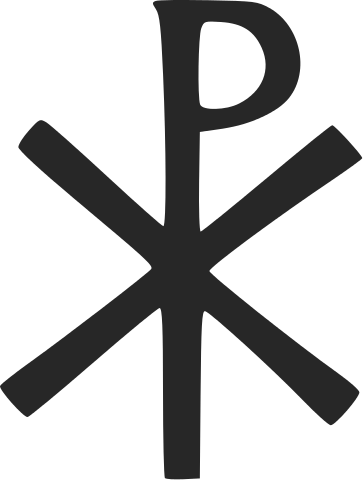Vision of the Cross
The Vision of Constantine is an event that occurred prior to the Battle of Milvian Bridge on 27 October 312. Roman Emperor Constantine I had a vision that he interpreted as a sign from the Christian god that he would be victorious against his rival, Emperor Maxentius. The experience of having the vision and winning the battle eventually led Constantine to embrace Christianity and convert later in life.
Constantine's vision
Lactantius states that, in the night before the battle, Constantine was commanded in a dream to "delineate the heavenly sign on the shields of his soldiers" (On the Deaths of the Persecutors 44.5). He followed the commands of his dream and marked the shields with a sign "denoting Christ". Lactantius describes that sign as a "staurogram", or a Latin cross with its upper end rounded in a P-like fashion. There is no certain evidence that Constantine ever used that sign, opposed to the better known Chi-Rho sign described by Eusebius.
From Eusebius, two accounts of the battle survive. The first, shorter one in the Ecclesiastical History promotes the belief that the Christian God helped Constantine but does not mention any vision. In his later Life of Constantine, Eusebius gives a detailed account of a vision and stresses that he had heard the story from the Emperor himself. According to this version, Constantine with his army was marching (Eusebius does not specify the actual location of the event, but it clearly is not in the camp at Rome), when he looked up to the sun and saw a cross of light above it, and with it the Greek words " Ἐν Τούτῳ Νίκα", En toutō níka, usually translated into Latin as "in hoc signo vinces". The literal meaning of the phrase in Greek is "in this (sign), conquer" while in Latin it's "in this sign, you shall conquer"; a more free translation would be "Through this sign [you shall] conquer". At first he was unsure of the meaning of the apparition, but in the following night he had a dream in which Christ explained to him that he should use the sign against his enemies. Eusebius then continues to describe the labarum, the military standard used by Constantine in his later wars against Licinius, showing the Chi-Rho sign.
The accounts of the two contemporary authors, though not entirely consistent, have been merged into a popular notion of Constantine seeing the Chi-Rho sign on the evening before the battle. Both authors agree that the sign was not widely understandable to denote Christ (although among the Christians, it was already being used in the catacombs along with other special symbols to mark and/or decorate Christian tombs). Its first imperial appearance is on a Constantinian silver coin from c. 317, which proves that Constantine did use the sign at that time, though not very prominently. He made more extensive use of the Chi-Rho and the Labarum later, during the conflict with Licinius.
Analysis
Some have considered the vision in a solar context (e.g. as a solar halo phenomenon called a sun dog), which may have preceded the Christian beliefs later expressed by Constantine. Coins of Constantine depicting him as the companion of a solar deity were minted as late as 313, the year following the battle. The solar deity Sol Invictus is often pictured with a nimbus or halo. Various emperors portrayed Sol Invictus on their official coinage, with a wide range of legends, only a few of which incorporated the epithet invictus, such as the legend SOLI INVICTO COMITI, claiming the Unconquered Sun as a companion to the emperor, used with particular frequency by Constantine.
Constantine's official coinage continues to bear images of Sol until 325/6. A solidus of Constantine as well as a gold medallion from his reign depict the Emperor's bust in profile jugate with Sol Invictus, with the legend INVICTUS CONSTANTINUS. The official cults of Sol Invictus and Sol Invictus Mithras were popular amongst the soldiers of the Roman Army. Statuettes of Sol Invictus, carried by the standard-bearers, appear in three places in reliefs on the Arch of Constantine. Constantine's triumphal arch was carefully positioned to align with the colossal statue of Sol by the Colosseum, so that Sol formed the dominant backdrop when seen from the direction of the main approach towards the arch.
